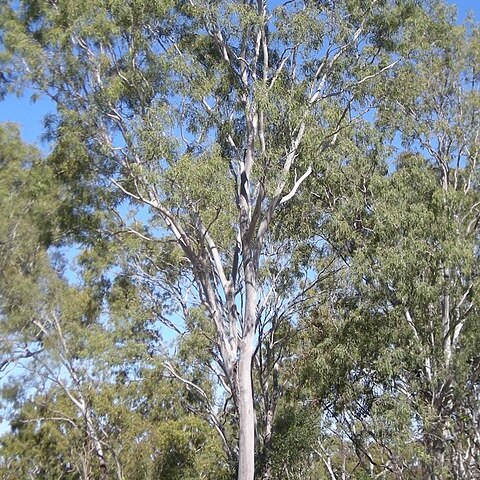Tree to 35 m tall. Forming a lignotuber. Bark rough on lower 1–4 m of trunk, tessellated, dark grey to black, abruptly changing to whitish smooth bark that is sometimes powdery. Juvenile growth (coppice or field seedlings to 50 cm): stem rounded in cross-section; juvenile leaves sessile or shortly petiolate and opposite for 7–11 nodes then alternate, lanceolate, 5.5–11 cm long, 1–2 cm wide, tapering to petiole, slightly discolorous, dull, grey-green to green; stems, petioles and midribs setose for about the first 5 nodes. Adult leaves alternate, petiole 0.5–1.5 cm long; blade narrowly lanceolate to linear, 9–24 cm long, 0.6–2.5 cm wide, base tapering to petiole, concolorous, glossy or dull, green to grey-green, strongly penniveined, densely to very densely reticulate, intramarginal vein parallel to and just within margin, oil glands island or obscure. Inflorescence axillary compound, with an expanded rhachis with 2 to 4 internodes, peduncles 0.2–0.7 cm long, buds 3 or 7 per umbel, pedicels 0.1–0.4 cm long. Mature buds ovoid to pyriform, 0.4–0.6 cm long, 0.3–0.5 cm wide, scar present (outer operculum shed during bud development), operculum rounded and often apiculate, stamens inflexed, anthers cuboid to oblong, versatile, dorsifixed, dehiscing by longitudinal slits (non-confluent), style long, stigma tapered, locules 3, the ovules not arranged in distinct vertical rows on the placentae. Flowers white. Fruit pedicellate (pedicels 0.1–0.3 cm long), cylindrical or urceolate, 0.6–1.2 cm long, 0.6–1 cm wide, thin-walled, disc descending, valves 3, enclosed. Seeds brown or reddish brown, 1.5–2.2 mm long, flattened or saucer-shaped, hilum ventral. Cultivated seedlings (measured at ca node 10): cotyledons reniform to orbicular; stems rounded in cross-section, scabrid with both multicellular bristles and simple hairs; leaves shortly petiolate, opposite for ca 7 to 10 (? or more) nodes before becoming alternate, ovate to lanceolate, 4–12 m long, 1.5–4.5 cm wide, base tapering, margin entire, apex pointed, slightly discolorous, green, paler beneath; lamina slightly scabrid with similar hairs to stems.
More
Tree to 30 m. Bark tessellated, dark grey up to 2 m, smooth and white above. Juvenile leaves sessile or almost so, narrowly lanceolate or oblong. Adult leaves alternate, petiolate, narrowly lanceolate, acute or acuminate, thin; lamina 12–16 cm long, 1–1.6 cm wide, dull, grey-green; lateral veins fine, at 45°–65°; intramarginal vein almost confluent with margin; petiole terete, channelled or slightly flattened, 5–10 mm long. Conflorescence axillary, decussate; umbels 3-flowered; peduncle terete, 2–4 mm long; pedicels 2–3 mm long. Buds pyriform; operculum apiculate, 1–2 mm long, 3–4 mm wide; hypanthium truncate-ovoid or campanulate, 4–6 mm long, 3–5 mm wide. Fruits truncate-ovoid or subcylindrical, rarely suburceolate, 8–11 mm long, 6–8 mm wide. Seeds narrowly winged.


